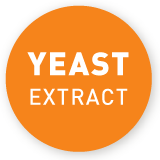Yeast extract was often mentioned in connection with glutamate during the recent public discussions on labelling and transparency. Participants at the conference used this opportunity to share their knowledge on the production of yeast extract and particularly its special composition. Yeast extract is produced from yeast and consists of proteins, amino acids, carbohydrates, vitamins (in particular vitamin B) and minerals.
One of the unique features of yeast extract is its profile of 20 amino acids, including glutamic acid. This also distinguishes it from monosodium glutamate. These amino acids give yeast extract its characteristic taste. Its taste is very close to the one of meat broth, as the amino acid profile of yeast extracts is very similar to that of meat broth even though yeast extract is free from animal components. “Thanks to its natural composition, yeast extract creates a special taste experience that appeals to both the mouth and the nose”, said Yolanda Werner from the European Association for Speciality Yeast Products (EURASYP). “Due to this special amino acid profile and the intensity of flavour that results, only small amounts of yeast extract have to be added during food production.“ Usually, the concentration of yeast extract in food is less than 1%. If yeast extract is part of the recipe, it is mainly listed as ‘yeast extract’ and sometimes as ‘natural flavouring’.



